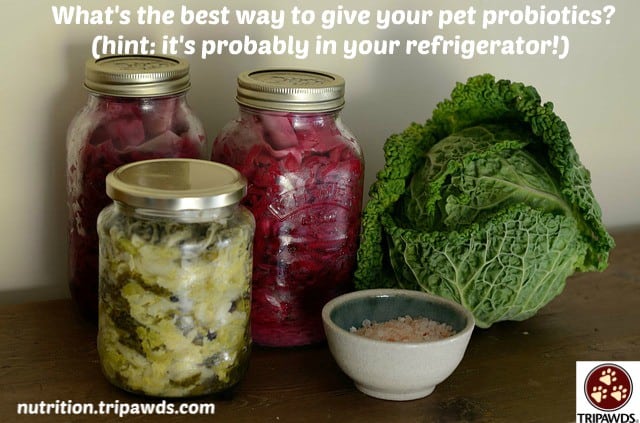The intestines make up the largest immune system in a pet’s body, so making sure they have a strong intestinal tract is key to fighting off harmful organisms. Store bought kibble with pet food prebiotics and probiotics seem like a smart way to do it, but can these foods really get the job done?
How to Add Live Pet Food Prebiotics and Probiotics into Your Pet’s Meals

Our pets benefit from beneficial bacteria in the gut, just like we do. These hard-working micro-organisms keep our intestines healthy by moving nutrients through the intestines while keeping inflammation down and stomping out bad pathogens. Here’s how they differ, according to vet nutrition expert Dr. Karen Becker:
- Prebiotics are are non-digestible food ingredients that feed the growth of intestinal bacteria.
- Probiotics maintain healthy levels of good bacteria.
Unfortunately, “Most probiotics added to commercial pet diets are killed off during the manufacturing process,” writes Dr. Karen Becker in her article, Even the Most Careful Pet Parent Can Easily Make This Trendy Mistake. “If you happen to run across a pet food claiming to contain probiotics, just leave it on the shelf.”
In her 2018 WVC presentation “What Do Prebiotics and Probiotics Really Do?” feline nutrition expert Ann Wortinger, BIS LVT VTS, agrees and says that even pill form prebiotics and probiotics don’t often deliver. “Most commercially available products suffer tremendous loss of activity during storage. After 5-6 months of storage, virtually no live organisms are present.”
Easy DIY Probiotics Recipe for Pets
Dr. Judy Morgan, author of Yin & Yang Nutrition for Dogs, tackles the probiotics issue by encouraging pet parents to use whole, fresh foods in their dog or cat’s diet. “Probiotics can be added to the diet through supplementation or feeding of fermented foods like vegetables or raw milk (cow, sheep, goat),” she writes.
Dr. Morgan’s KimChi for Pets Recipe
In her book, Dr. Morgan shares a KimChi recipe to add probiotics into a dog’s diet. While we have read in many places that cats can eat KimChi, be sure to check with your vet if you decide to feed it to yours. Also, be aware that KimChi has a funky smell some people find distasteful. Your pet will probably love it!
- Make a brine: combine 2 tsp sea salt with 4 cups distilled or spring water. Set aside.
- Grind 2 tablespoons ground fresh ginger root and 4 crushed garlic cloves. Add to the brine.
- Grind fruits and vegetables for the mix. Dr. Morgan suggests red or green cabbage, carrots, apples, pears, daikon radishes, red or orange peppers, and red radishes.
- Pour the brine and herb mixture over the vegetables in a large glass jar.
- Seal jar loosely and allow to sit at room temperature for 4 to 5 days for fermentation to occur.
- After 4 to 5 days, place the jar in the refrigerator to stop fermentation.
This blend can last up to one year as long as it’s refrigerated. you can even portion and freeze it in small batches. Serve at mealtime. Just add one teaspoon of food to your dog’s diet, for every 20 pounds of body weight. Cats would obviously need far less.
For more great recipes to boost your pet’s health, please check out Yin & Yang Nutrition for Dogs. For cats, see What Cats Should Eat: How to Feed Your Cat for Optimal Health, by Jean Hofve DVM
Dr. Becker Discusses Fermented Vegetables for Pets

1 thought on “An Easy Way to Add Pet Food Prebiotics and Probiotics into Meals”
Comments are closed.